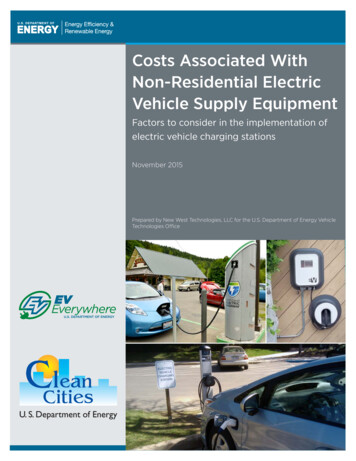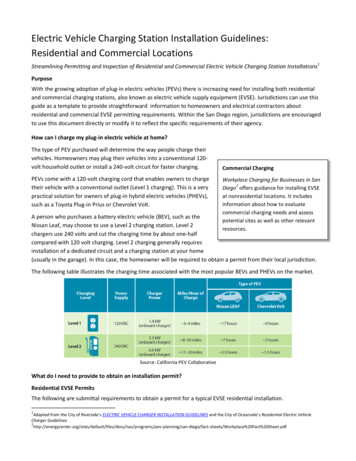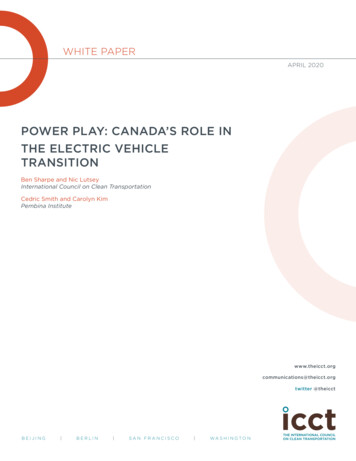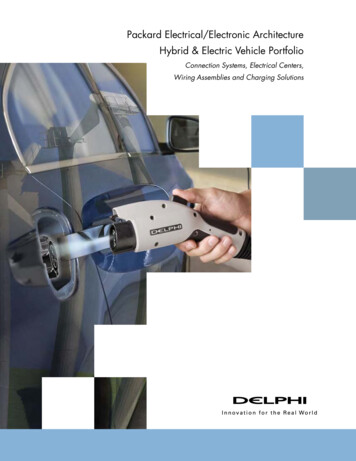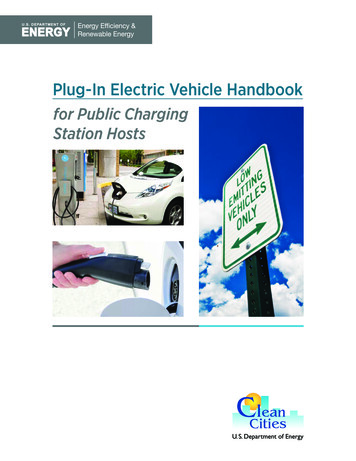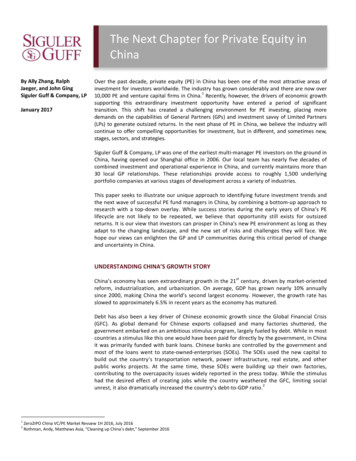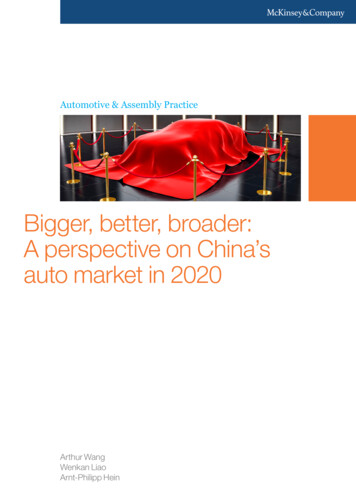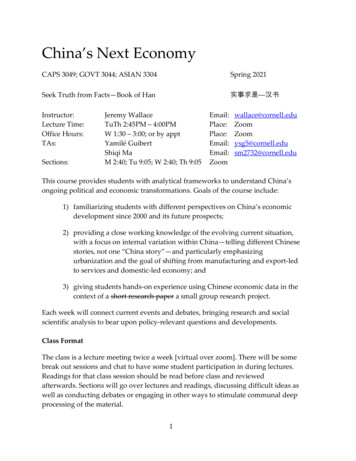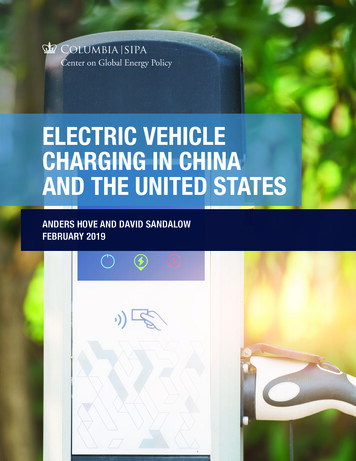
Transcription
ELECTRIC VEHICLECHARGING IN CHINAAND THE UNITED STATESANDERS HOVE AND DAVID SANDALOWFEBRUARY 2019
ABOUT THE CENTER ON GLOBAL ENERGY POLICYThe Center on Global Energy Policy provides independent, balanced, data-driven analysisto help policymakers navigate the complex world of energy. We approach energy as aneconomic, security, and environmental concern. And we draw on the resources of a worldclass institution, faculty with real-world experience, and a location in the world’s finance andmedia capital.Visit us at www.energypolicy.columbia.edu@ColumbiaUenergyABOUT THE SCHOOL OF INTERNATIONAL AND PUBLIC AFFAIRSSIPA’s mission is to empower people to serve the global public interest. Our goal is to fostereconomic growth, sustainable development, social progress, and democratic governanceby educating public policy professionals, producing policy-related research, and conveyingthe results to the world. Based in New York City, with a student body that is 50 percentinternational and educational partners in cities around the world, SIPA is the most global ofpublic policy schools.For more information, please visit www.sipa.columbia.edu
ELECTRIC VEHICLECHARGING IN CHINAAND THE UNITED STATESANDERS HOVE AND DAVID SANDALOWFEBRUARY 20191255 Amsterdam AveNew York NY 10027www.energypolicy.columbia.edu@ColumbiaUenergy
ELECTRIC VEHICLE CHARGING IN CHINA AND THE UNITED STATESTABLE OF CONTENTSEXECUTIVE SUMMARY5INTRODUCTION7GLOSSARY910BACKGROUND: ELECTRIC VEHICLES10A. Electric Vehicle Deployment TodayB. Electric Vehicle Deployment Projections11C. Electric Vehicle Policies13i. China13ii. United States14161. EV CHARGING TODAYA. EV Charging in China16B. EV Charging in the United States19C. Role of Charging Infrastructure in EV Purchase Decisions21D. Comparison — China and the United States222. EV CHARGING PROJECTIONS233. EV CHARGING POLICIES26A. EV Charging Infrastructure Policy in China26i. General26ii. Utility Rate Design28B. Charging Infrastructure Policy in the United States29i. General29ii. Utility Rate Design31C. Comparison - China and the United States4. EV CHARGING TECHNOLOGIESA. Charging Level343535ENERGYPOLICY.COLUMBIA.EDU FEBRUARY 2019 3
ELECTRIC VEHICLE CHARGING IN CHINA AND THE UNITED STATESB. Charging Standards36i. China36ii. United States36C. Charging Communication Protocols38D. Costs38E. Wireless Charging39F. Battery Swapping395. EV CHARGING BUSINESS MODELSA. Independent Charging Networks4141i. China41ii. United States43B. Utility Companies44i. China44ii. United States44C. Auto Manufacturer Charging Networks46D. Shopping Malls, Hotels and Restaurants47i. China47ii. United States47E. Fueling Stations49F. Sharing Economy49G. Mobile Charging Units50H. Commercial Parking Lots52I. Municipal EV Charging53J. Comparison — China and the United States546. CONCLUSION56NOTES60ACKNOWLEDGEMENTS84ABOUT THE AUTHORS854 CENTER ON GLOBAL ENERGY POLICY COLUMBIA SIPA
ELECTRIC VEHICLE CHARGING IN CHINA AND THE UNITED STATESEXECUTIVE SUMMARYAt least 1.5 million electric vehicle (EV) chargers have now been installed in homes,businesses, parking garages, shopping centers and other locations around the world. Thenumber of EV chargers is projected to grow rapidly as the electric vehicle stock grows in theyears ahead.The EV charging industry is a highly dynamic sector with a wide range of approaches. Theindustry is emerging from infancy as electrification, mobility-as-a-service and vehicle autonomyinteract to produce far-reaching changes in transportation.This report compares EV charging in the world’s two largest electric vehicle markets -- China andthe United States – examining policies, technologies and business models. The report is basedon more than 50 interviews with industry participants and a review of the Chinese- and Englishlanguage literature. Findings include:1.The EV charging industries in China and the United States are developing largelyindependently of the other. There is little overlap among the key players in the EVcharging industries in each country.2. The policy frameworks with respect to EV charging in each country differ. The Chinese central government promotes the development of EV charging networksas a matter of national policy. It sets targets, provides funding and mandates standards.Many provincial and local governments also promote EV charging. The United States federal government plays a modest role in EV charging. Several stategovernments play active roles.3. EV charging technologies in China and the United States are broadly similar. In bothcountries, cords and plugs are the overwhelmingly dominant technology for chargingelectric vehicles. (Battery swapping and wireless charging have at most a minor presence.) China has one nationwide EV fast charging standard, known as China GB/T. The United States has three EV fast charging standards: CHAdeMO, SAE Combo and Tesla.4. In both China and the United States, many types of businesses have begun to offerEV charging services, with a range of overlapping business models and approaches.A growing number of partnerships are emerging, involving independent chargingcompanies, auto manufacturers, utilities, municipalities and others. The role of utility-owned public chargers is larger in China, especially along major longdistance driving corridors. The role of auto maker EV charging networks is larger in the United States.ENERGYPOLICY.COLUMBIA.EDU FEBRUARY 2019 5
ELECTRIC VEHICLE CHARGING IN CHINA AND THE UNITED STATES5. Stakeholders in each country could learn from the other. US policy makers could learn from the Chinese government’s multiyear planning withrespect EV charging infrastructure, as well as China’s investment in data collection onEV charging. Chinese policymakers could learn from the United States with respect to siting of publicEV chargers, as well as US demand response programs. Both countries could learn from the other with respect to EV business modelsAs the demand for EV charging grows in the years ahead, continued study of the similaritiesand differences between approaches in China and the United States can help policymakers,businesses and other stakeholders in both countries and around the world.6 CENTER ON GLOBAL ENERGY POLICY COLUMBIA SIPA
ELECTRIC VEHICLE CHARGING IN CHINA AND THE UNITED STATESINTRODUCTIONWe are in the early stages of a major infrastructure build-out. In China, the United States andother countries around the world, hundreds of thousands of electric vehicle chargers arebeing installed in homes, businesses, parking garages, shopping centers and other locations.The number of chargers is projected to grow rapidly in the years ahead as the electric vehiclestock grows.This build-out will require new behavior patterns and business models. For more than acentury, the vast majority of vehicles have been refueled at retail stations dispensing gasolineand/or diesel. Electric vehicle charging is different than this familiar model for a number ofreasons, including: Most recharging of electric vehicles takes place at home or work. EV charging is slower than filling a conventional vehicle with liquid fuel. EV charging is cheaper than filling a conventional vehicle with liquid fuel (which is goodfor the driver but means less revenue potential for businesses that provide charging). Electric utilities are more central players in EV charging than traditional fueling. Many governments are supporting the growth of EV charging infrastructure to helpachieve a range of social objectives.As a result of these and other factors, the EV charging industry is currently a highlydynamic sector with a wide range of approaches. The industry is emerging from infancy aselectrification, mobility-as-a-service and vehicle autonomy interact to produce some of themost far-reaching changes in the transportation sector in a century.This report compares electric vehicle charging in the world’s two largest electric vehiclemarkets—China and the United States—based on more than 50 in-person interviews and areview of the Chinese- and English-language literature. The report starts with backgroundon electric vehicles and EV charging infrastructure today. The report then explores threequestions:1.What policies are shaping the growth of EV charging?2. What technologies are being used?3. What business models are emerging as the EV charging industry grows?A final section offers conclusions and lessons each country could learn from the other.ENERGYPOLICY.COLUMBIA.EDU FEBRUARY 2019 7
ELECTRIC VEHICLE CHARGING IN CHINA AND THE UNITED STATESFigure 1A: Breakdown of interviews for this report - countrySource: AuthorsFigure 1B: Breakdown of interviews for this report - sectorSource: AuthorsRMB-U.S. Dollar ConversionDuring January 2019, the Chinese RMB and U.S. dollar exchanged at a rate of roughlyRMB 6.8 to 1. During the past 10 years, the two currencies have exchanged within arange of roughly RMB 6.0 to 1 to RMB 7.0 to 1, with an average exchange rate of justover RMB 6.5 to 1.18 CENTER ON GLOBAL ENERGY POLICY COLUMBIA SIPA
ELECTRIC VEHICLE CHARGING IN CHINA AND THE UNITED STATESGLOSSARYTermAbbreviation ExplanationElectric vehicleEVA vehicle propelled solely or in part by an electric motorpowered by batteries that can be recharged from a sourceoutside the vehicle. (Includes both all-electric vehicles and plugin hybrids.)All-electric vehicle/ battery electricvehicleAEV/BEVA vehicle propelled solely by an electric motor powered bybatteries that can be recharged from a source outside thevehicle.Plug-in hybridPHEVA vehicle propelled in part by an internal combustion engineand in part by an electric motor powered by batteries that canbe recharged from a source outside the vehicle.Internal combustionengineICEAn engine that runs on liquid fuels including gasoline or diesel.New energy vehicleNEVA term used in China for vehicles not powered by an internalcombustion engine. Last year roughly 99% of NEVs sold wereplug-in electric vehicles (all-electric or plug-in hybrids).Electric vehiclesupply equipment/ Electric vehicleservice equipmentEVSECharging infrastructure for electric vehicles. This broad termencompasses all types of charge posts and levels of chargingstations.Charging point /charging postA piece of equipment for charging an electric vehicle, otherthan an unmodified wall outletCharging stationA location with multiple charging points/posts.Level 1 chargerL1An EV charger using a standard 120 volt outlet. Often referredto as “trickle charging,” this is the slowest type of charger.Level 2 chargerL2An EV charger using a 240 volt electrical circuit, similar to adryer or an electric stove top.DC fast chargerDCFCA 480 volt charger that can deliver as much as hundreds of kWsof power. This is the fastest type of charger.Combined ChargingSystemCCSAn EV charging standard that originated in the EU; supportedby many automakers including Volkswagen, General Motors andHyundai.Charge de MoveCHAdeMOAn EV charging standard that originated in Japan; supported bymany automakers including Nissan and Mitsubishi.Tesla SuperchargerA proprietary EV 480 volt supercharger network deployed byTesla, with its own proprietary standard.ENERGYPOLICY.COLUMBIA.EDU FEBRUARY 2019 9
ELECTRIC VEHICLE CHARGING IN CHINA AND THE UNITED STATESBACKGROUND: ELECTRIC VEHICLESA. Electric Vehicle Deployment TodayIn 2018, roughly 1.25 million electric vehicles were sold in China—a 62% increase over 2017sales. Electric vehicles were roughly 4.5% of light-duty passenger vehicles sold.2As of January 2019, there were roughly 2.6 million electric vehicles on the roads in China.3In the United States, roughly 361,000 electric vehicles were sold in 2018—an 81% increase over2017 sales. Electric vehicles were roughly 2% of light-duty passenger vehicles sold.4As of January 2019, there were roughly 1.1 million electric vehicles on the roads in theUnited States.5The figures above do not include either low speed electric vehicles (LSEVs) or electric bicycles. LSEVs have top speeds of roughly 40 kilometers per hour/25 miles per hour. In 2016, morethan 500,000 LSEVs were sold in China.6 In the United States, LSEVs are largely confinedto gated communities, golf courses, malls, airports, public parks and tourist facilities.7 Electric bicycles are wildly popular in China. Roughly 200 million electric bicycles arein use, with roughly 30 million sold each year.8 Sales of electric bicycles in the UnitedStates are in the range of 200,000 units per year.9The average range of Chinese EVs is much less than the average range of U.S. EVs. In China,10 CENTER ON GLOBAL ENERGY POLICY COLUMBIA SIPA
ELECTRIC VEHICLE CHARGING IN CHINA AND THE UNITED STATESthe average range of the top 10 selling all-electric vehicle models is less than 200 km/124miles. In the United States, the average range of the top 10 selling all-electric vehicles is morethan 400 km/248 miles. This suggests a need for greater density of EV charging infrastructurein China.10Figure 2: Electric Vehicle SalesSource: IEA (2010-2017); Inside EVs (2018)Table 1: Comparison of China and U.S. light-duty EV salesChinaU.S.Electric vehicle sales (2018)1,250,000361,000Growth in 2018 vs prior year73%81%EV market share (new sales)4.5%2.1%All-electric vehicle sales (2018)984,000235,700Growth in 2018 vs prior year50.7%227%Total Electric vehicles on road2.6 million1.1 millionSource: China Car Association, Xinhua, China Passenger Car Market Information Alliance, Inside EVsB. Electric Vehicle Deployment ProjectionsForecasts of EV deployment vary widely. Some recent examples include: The Organization of Petroleum Exporting Countries (OPEC) forecasts that 11.6% ofpassenger cars worldwide will be EVs by 2040.11 The International Energy Agency’s 2017 World Energy Outlook projects 280 million EVson the road by 2040, which would represent 14% of the global fleet of roughly 2 billionvehicles at that time.12 The IEA’s 2018 Global EV Outlook projects 125 million EVs onENERGYPOLICY.COLUMBIA.EDU FEBRUARY 2019 11
ELECTRIC VEHICLE CHARGING IN CHINA AND THE UNITED STATESthe road by 2030 under the IEA’s New Policies Scenario (representing 6% of the globallight-duty vehicle stock).13 BP’s “Evolving Transition” scenario suggests that 15% of vehicles will be EVs by 2040,but 30% of vehicle miles traveled will be powered by electricity.14 Morgan Stanley forecasts that EVs will represent around 25% of global vehicle stock by2040 and surpass 55% of vehicle stock by 2050.15 In its 2018 EV Outlook, Bloomberg New Energy Finance projects that 55% of new carsales and 33% of the world’s vehicle fleet will be EVs by 2040.16 A “fast adoption” scenario set forth in one International Monetary Fund working papersuggests 90% penetration by 2042.17 The analysts at RethinkX, a consulting firm working on disruptive technology, projectthat transport-as-a-service and autonomous vehicle technology will enable EVs toreplace virtually all privately owned and commercial vehicles as early as 2030.18 Incontrast, a 2016 Mckinsey study projects a 15% market share for autonomous vehiclesand less than 10% for shared vehicles (autonomous or not).19The wide range of forecasts reflects different assumptions concerning battery costs, publicpolicies and the impacts of mobility-as-a-service and vehicle autonomy, among other factors.EV deployment rates in China will be strongly affected by government targets. The Chinesegovernment new energy vehicle targets currently include sales of 2 million per year by 2020and 20% of total vehicle production and sales—or over 7 million vehicles annually—by 2025.20According to a technology road map of the Ministry of Industry and Information Technology(MIIT), EVs could reach 40% of new vehicle sales in China by 2030.21 The projections in otherstudies vary: A 2017 Tsinghua University study estimated EVs would account for 7% of vehicle salesin Beijing in 2030 without policy supports or technology breakthroughs and over 70%of sales and half the vehicle stock with aggressive policy support and technologyprogress.22 Bloomberg New Energy Finance forecasts EVs to reach 10% of Chinese new vehiclesales by 2025 and surpass 50% by 2035.23 The World Wildlife Fund expects China to reach over 90% of EV sales within 10–20years.24Forecasts of EV penetration in the US market vary:25 In the US Energy Information Administration’s 2018 “Reference Case,” EVs reach 7% ofnew vehicle sales in 2025 and 19% in 2050.26 The consultancy Energy Innovation estimates that EV sales will reach 10% of new USvehicle sales soon after 2025, 20% around 2030 and 65% by 2050.2712 CENTER ON GLOBAL ENERGY POLICY COLUMBIA SIPA
ELECTRIC VEHICLE CHARGING IN CHINA AND THE UNITED STATES Bloomberg New Energy Finance forecasts that EVs will reach 10% of new US vehiclesales by 2025 and 50% by 2035.28C. Electric Vehicle Policiesi. ChinaThe Chinese government promotes electric vehicles with a variety of policies includingsubsidies, rebates, quotas for vehicle manufacturers and tax exemptions. Many provincial andlocal governments do the same. City policies favoring EVs in obtaining license plates havebeen especially important.National subsidies have been a major incentive for consumers to purchase EVs. China’s centralgovernment began subsidizing EV purchases for government and public fleets in 2009 andindividual car buyers in 2013. Subsidies in 2013 ranged from RMB 35,000 to RMB 60,000,depending on the vehicle’s electric range, and have been reduced regularly since.29 Subsidieswere paid directly to manufacturers, based on vehicle registrations and sales. These subsidiesattracted many companies into EV manufacturing, including some with no car manufacturingexperience. Criticism of the subsidies, along with reports of fraud by companies receivingsubsidies, prompted a policy redesign.30In early 2018, the Chinese central government updated its EV subsidies, linking automakerfuel economy credits with new electric vehicle (NEV) production targets.31 Subsidies arenow available for vehicles with range over 150 km on the test cycle used in China, which isbased on the New European Driving Cycle (NEDC).32 An NEDC range of 400 km is needed toreceive the highest subsidy.33 Requirements tied to battery performance were also made morestringent: batteries must have energy density over 105 Wh/kg to receive a subsidy and at least140 Wh/kg to receive the full subsidy.34 Local governments are permitted to offer additionalsubsidies up to 50% of the level of national subsidies.35 Government officials have said EVsubsidies should phase out by 2020.36In addition to subsidies, China has promoted EVs with nonfinancial incentives, includingexemption from city license plate lotteries or restrictions. This has been an especiallyimportant incentive since applicants often wait years to acquire a license plate for aconventional vehicle. (In Beijing in 2016, 2.7 million people registered for a license platelottery with only 90,000 plates available for conventional vehicles. In 2018, the number ofconventional vehicle license plates available fell to just 40,000.37 In Shanghai, EV plates areavailable for free, while regular plates cost over 12,000.38) Initially, license plates for EVs wereavailable through a simple queue.39 Today, EV plates are distributed by lottery, with moreplates available for EVs than conventional vehicles.In addition, cars with EV plates may have privileges such as access to restricted traffic zones.Many large Chinese cities, including Beijing, restrict drivers of passenger cars from enteringthe city on certain days based on license plate number, while exempting EVs from such limits.A few cities in China use special parking access or discounts, lane access and congestion zonediscounts to promote EVs.40ENERGYPOLICY.COLUMBIA.EDU FEBRUARY 2019 13
ELECTRIC VEHICLE CHARGING IN CHINA AND THE UNITED STATESIn September 2017, the Ministry of Industry and Information Technology finalized its newenergy vehicle (NEV) quota, which requires all carmakers with over 30,000 annual vehiclesales in the country to produce 10% NEVs in 2019 and 12% in 2020. The policy also integratesNEV quotas with new corporate average fuel consumption (CAFC) requirements. A tradingmechanism incorporates mandates for both NEV and CAFC attributes. An analysis by theInternational Council on Clean Transportation (ICCT) suggests the credit trading mechanismwill enable carmakers to meet the 2020 quota with about 4% NEVs.41Fleet EVs remain a sizeable portion of China’s EV market. Cities including Taiyuan andShenzhen continue to electrify taxi, bus, ride-hailing and bus fleets at a rapid pace. In May2018, Shenzhen announced it would allow EVs only in taxi and ride-hailing fleets and requireall commercial trucks to be EVs—along with installing over 5,000 dedicated taxi chargingposts by 2020.42Chinese policy makers have several motivations for pursuing policies related to electricvehicles, including promoting domestic manufacturing of batteries and vehicles, decreasingdependence on imported oil and reducing emissions: In 2014, President Xi Jinping said that electric mobility is an emerging technology inwhich China has the ability to leapfrog other global automakers.43 Many of China’s EVpolicies benefit domestic manufacturers and promote use of Chinese-made batteries invehicles while encouraging foreign carmakers to share technology with Chinese jointventure partners.44 Reducing oil imports is a second important objective of Chinese EV policies. Since2017, China has been the world’s largest oil importer.45 Oil accounts for over 10% ofChina’s import volume by value.46 Gasoline demand is rising quickly due to increased carownership and driving. Cutting emissions of urban air pollutants and greenhouse gases is another motive forpursuing EVs. Transportation sector emissions are a major contributor to ambient PM2.5haze in major cities of China.47 Adopting EVs has significant potential to benefit urbanair quality, even though much of China’s electricity presently comes from coal. Overthe medium to long term, vehicle electrification will be essential to decarbonizing thetransportation sector in China.48ii. United StatesThe US federal government offers EV purchasers a tax credit of 2,500 to 7,500 per vehicle,depending on battery size. The tax credit is available for the first 200,000 vehicles sold byeach manufacturer, after which it begins to phase out for that manufacturer.49 Federal fuelefficiency standards also provide incentives for manufacturers to sell electric vehicles.50Many US states have tax credits or rebates for the purchase of EVs. Among the most generousare Colorado, California, Delaware and Massachusetts. Georgia, Illinois, Maryland, SouthCarolina and Tennessee have offered tax credits or rebates in the past but have now retired orscaled back those programs.5114 CENTER ON GLOBAL ENERGY POLICY COLUMBIA SIPA
ELECTRIC VEHICLE CHARGING IN CHINA AND THE UNITED STATESMany observers consider the multistate zero emissions vehicle (ZEV) program to be the mostimportant EV policy in the United States.52 The program requires ZEVs to account for roughly8% of vehicle sales in ZEV states by 2025. (The ZEV states are California, Connecticut, Maine,Maryland, Massachusetts, New Jersey, New York, Oregon, Rhode Island and Vermont.) Todate the mandate has mostly encouraged EV sales in California, which accounted for 50.7%of EV sales in the United States in 2016. This is due in part to a “travel provision” that allowedautomakers to earn credit for vehicles sold in California in the other seven states with ZEVmandates. This travel provision is now being scaled back, and EV sales in other ZEV statesmay grow as a result.53High occupancy vehicle (HOV) lane exemptions have been an important incentive for EVpurchases in the United States. More than 10 states (including California, Colorado and NewYork) allow EVs access to HOV lanes.54Federal and state government goals in promoting electric vehicles include reducing emissions,improving fuel economy and promoting US technology leadership.ENERGYPOLICY.COLUMBIA.EDU FEBRUARY 2019 15
ELECTRIC VEHICLE CHARGING IN CHINA AND THE UNITED STATES1. EV CHARGING TODAYA. EV Charging in ChinaIn January 2019, the Chinese Electric Vehicle Charging Infrastructure Promotion Agency(EVCIPA) reported 808,000 EV chargers in China. Of these, roughly 330,000 were publicchargers and 480,000 were home chargers. The number of chargers reported by EVCIPAgrew 80% since January 2018.55(Other data suggests the number of EV chargers in China could be even higher. Accordingto EVCIPA as well as interviews conducted for this report, most EVs sold for personal use inChina are accompanied by a home charging unit. Roughly 1.5-2 million EV’s have been sold inChina for personal use. Although not all home charging units sold with EVs are installed, thissuggests the number of home EV chargers could be higher than 480,000.)China’s first-tier cities have taken the lead in EV charging infrastructure. This partly reflectsthe legacy of earlier central government policies, in particular the EV pilots that began in2009 under the Ten Cities, Thousand Vehicles program. At the end of 2018, Beijing, Shanghaiand Guangdong Province (home to Shenzhen and Guangzhou) accounted for just under 40%of charging posts nationwide.56Nevertheless, EV charging infrastructure is growing rapidly throughout China. The majority ofprovinces added over 1,000 new charging posts in 2018. Several provinces grew the numberof charging posts by over 100%. Most provinces in China now have more than 2,000 publiccharging posts.5716 CENTER ON GLOBAL ENERGY POLICY COLUMBIA SIPA
ELECTRIC VEHICLE CHARGING IN CHINA AND THE UNITED STATESAccording to industry experts interviewed for this study, most home EV charging in Chinatakes place with chargers distributed by carmakers at the time of purchase and installedaccording to official procedures. Nevertheless, in some Chinese cities it is not unusual tosee informal “fly-line” charging with extension cords passed through windows and doorsto vehicles parked at the curb.58 Fly-line charging to the curb reflects a shortage of privateparking and lack of access to charging even when private parking is available. Such practices,if left uncontrolled, could create distribution grid reliability issues, as many older Chinese urbanneighborhoods have insufficient distribution capacity for heavy volumes of EV charging.59FIgure 3: Photos of informal “fly line” charging in BeijingSource: Anders Hove (left, March 2018) and Rob Earley (right, July 2017)Highway corridors for EV charging have now been installed between Beijing and Shanghaias well as other major cities. Utilization of these facilities is heaviest on weekends and majorpublic holidays. During February 2018, the amount of electricity consumed at State Gridchargers along highways more than doubled versus the prior month due to the annual SpringFestival holiday.60ENERGYPOLICY.COLUMBIA.EDU FEBRUARY 2019 17
ELECTRIC VEHICLE CHARGING IN CHINA AND THE UNITED STATESFIgure 4: China State Grid highway charging corridors as of early �53.4km临港-光明29.2km沪芦高速标注:① � .8km③ 叶榭服务区至航头服务区距离29.5km④ m台州⑤ 叶榭服务区至庄行服务区距离33km⑥ ��务区19.5km52.7km38kmm28k六安窦服33.3k 庄 务区荣炳 45km大服4km 墅 43.7km锦屏山-浦南20.6kmm成子湖km � 桥服18.5务km m官塘30.6km 1.4km67k33.6km 0kmG
New energy vehicle NEV A term used in China for vehicles not powered by an internal combustion engine. Last year roughly 99% of NEVs sold were plug-in electric vehicles (all-electric or plug-in hybrids). Electric vehicle supply equipment / Electric vehicle service equipment EVSE Charging infrastructure for electric vehicles. This broad term
